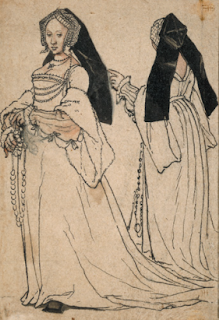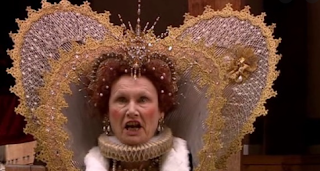Jane, Lady Rochford's Last Effects.
Jane Rochford, as portrayed by Jessica Raine in the TV drama Wolf Hall.
Everything went spectacularly wrong for Jane Boleyn, Lady Rochford, in autumn 1541. By then, she really should have known better. But what did she leave behind?
Jane had already survived one dramatic Henrician coup, seeing her husband and sister-in-law condemned to death on the flimsiest charges by a king unprepared to let anything stand in his way. Even the truth. Contrary to popular depictions of Jane, though, she did not condemn her relations, or contribute to their downfall. Records suggest a close relationship with Anne, and a civilized, if childless, marriage to George. Jane is only mentioned once in the trial records, where she admits that Anne confided in her about Henry's lack of sexual prowess. And this happened indirectly, addressed to George in the form of a question, which he was indiscreet enough to repeat aloud to the court. It was the hostile George Wyatt, writing later, who called Jane a "wicked wife," after her husband's blood. The finger of blame was actually pointed at Anne by Elizabeth, Countess of Somerset, whose role history may have conflated with Jane's, for the purpose of having a foil for the enduringly popular Anne.
Jane returned to court, secured a pension of £100, retained her title and served Henry's subsequent queens. This points to success, and forgiveness. She gave evidence in the annulment of Anne of Cleves' marriage in July 1540, and swiftly moved on to Catherine Howard, a teenager young enough to have been her own daughter. Until this point, Jane had been a shrewd survivor of Tudor realpolitik, but her affection for Howard led her into dangerous territory, keeping watch while the new queen met with privy chamberer Thomas Culpepper, whose beauty had Catherine infatuated. Jane's motives can only be guessed at. Whether she thought they would get away with it, or she could ride this wave, or if she was caught up in the romance, or encouraging Catherine to conceive a child, it was an extremely ill-advised move. When the affair came to light, Jane was examined, imprisoned, and quickly condemned Catherine, with her interrogators recording that Jane firmly believed the pair had consummated their love.[1]
Jane's mental health unraveled in the Tower. The law prohibited the condemnation of those of unsound mind, but Henry was so determined to send her to her death that he changed the law. She was executed on a block fresh with Catherine's blood, on 13 February 1542.
I have long been fascinated by Jane's story, especially what it reveals about the ways historical reputations are formed, rightly or wrongly. A forthcoming Channel 5 documentary about Jane, for which I was filmed at Hever Castle in March 2021 (air date tbc) will help set the record straight about her life. It was while I was researching my latest book, "Woodsmoke and Sage," a study in material culture, that I came across this list in the Letters and Papers of Henry VIII, which details Jane's last personal effects, confiscated upon her arrest. Obviously there were other things she left; a house, clothing furniture, but I love the immediacy of these items. Although we cannot touch, or see them, they somehow make Jane come alive for me, so I wanted to share them for others interested in her life to enjoy too:
A little steel casket with a purse and forty pounds in it
A brooch with an agate
A cross of diamonds with three pearls pendant
A flower of rubies
A flower with a ruby and a great emerald with a pearl pendant
A tablet of gold with black, green, and white enamelled
A pair of bracelets of red cornelians
A pair of beads of gold and stones
A broach of gold with an antique head and a white face.[2]
These were obviously Jane's treasured items, perhaps associated with people from the past, or gifts, or adornments to wear at court. Perhaps she wore those gold beads when she married George, or the red cornelian bracelets when they danced together.
I explore more bequeathed and confiscated items, wardrobe contents and jewellery owned by the Tudors, in my forthcoming book, Woodsmoke and Sage, due out 31 August, 2021.
NOTES:
[1] Letters and Papers of Henry VIII, Volume 16 pp613-629 1339
[2] Ibid 1340




Comments
Post a Comment